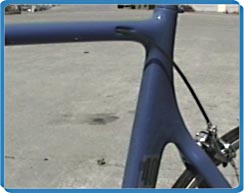|

|
|
Aerodynamics
Page: 1 of 2
|
|

Every bicyclist has to overcome wind resistance. Most recreational
bicycles in which the rider sits up have very poor aerodynamics. While newer
bicycles are being designed with better aerodynamics in mind, the human
body is simply not well designed to slice through the air. Bicycle racers
are aware of the problem of wind resistance and over the years have developed
techniques for reducing it. Bicycle designers and inventors have experimented
in developing alternative bicycle designs and HPVs (human- powered vehicles)
with an emphasis on better aerodynamic performance.
|

Charley "Mile-a-Minute" Murphy was an early cycling racer. His
"mile-a-minute" feat was accomplished in 1899. At that time he
traveled faster than the fastest automobile. Notice the large windscreen
on the train in front of him which greatly reduced wind resistance.
BICYCLE INSTITUTE OF AMERICA
|
|
|
Wind Resistance
Every cyclist who has ever pedaled into a stiff headwind knows about wind
resistance. It's exhausting! In order to move forward, the cyclist must
push through the mass of air in front of her. This takes energy. Aerodynmaic
efficiency--a streamlined shape that cuts through the air more smoothly--enables
a cyclist to travel much faster, with less effort. But the faster the cyclist
goes, the more wind resistance he experiences, and the more energy he must
exert to overcome it. When racing cyclists aim to reach high speeds, they
focus not only on greater power, which has its human limitations, but also
on greater aerodynamic efficiency.
Aerodynamic drag consists of two forces: air pressure drag
and direct friction (also known as surface friction or skin friction). A
blunt, irregular object disturbs the air flowing around it, forcing the
air to separate from the object's surface. Low pressure regions from behind
the object result in a pressure drag against the object. With high pressure
in the front, and low pressure behind, the cyclist is literally being pulled
backwards. Streamlined designs help the air close more smoothly around these
bodies and reduce pressure drag. Direct friction occurs when wind comes
into contact with the outer surface of the rider and the bicycle. Racing
cyclists often wear "skinsuits" in order to reduce direct friction.
Direction friction is less of a factor than air pressure drag.
|
On a flat road, aerodynamic drag is by far the greatest barrier to a cyclist's
speed, accounting for 70 to 90 percent of the resistance felt when pedaling.
The only greater obstacle is climbing up a hill: the effort needed to pedal
a bike uphill against the force of gravity far outweighs the effect of wind
resistance.
|
|
Calculate the Aerodynamic Drag and Propulsive Power of a Bicyclist
|
|
Fill in the information in the boxes.
Velocity
is your velocity (mi/hr) as read on a speedometer.
+ (plus) is forward
- (minus) is backward.
Wind velocity
(mi/hr) is - (minus) if it is a tailwind, + (plus) if it
is a headwind (relative to the ground).
Weight
is in pounds.
Grade
is the angle of the slope. 0 is flat, 90 is a vertical wall.
Click on the "Calculate" button.
Notice the drag force and power required to keep you moving at a constant
velocity.
|
This calculation requires a JavaScript-capable browser.
|
Notes on the calculator:
Please be aware that we've made some assumptions in order to simplify this calculation. For instance, this calculator does not take into account the body position (or size) of the rider in regard to wind resistance. In addition, other factors, such as the coefficient of friction are fixed. Also, if you put in "unrealistic" figures you will get unrealistic results.
Finally, please be aware that the "Calories per minute" figure is assuming that the human body is 100 percent efficient--this is not the case (20 percent efficiency is closer). For a more accurate figure try multiplying the "Calories per minute" by a factor of five.
|
|
Reducing resistance
Frame builders and designers have been working on creating
more aerodynamically efficient designs. Some recent designs have concentrated
on shifting from round tubes to oval or tear-shaped tubes. There is a delicate
balancing act between maintaining a good strength-to-weight ratio while
improving aerodynamic efficiency. Improvements to wheels have made perhaps
the biggest impact. A standard spoked wheel has been described as an "egg
beater," creating many small eddies as the tire rotates--creating drag.
Disc wheels, while generally heavier than their spoked counterparts, produce
less wind drag and turbulence when they spin.
|

This racing frame uses tear-shaped tubes
to reduce drag.
|
|
While improvements to frames and components have improved aerodynamic performance,
the cyclist is the largest obstacle to dramatic improvement. The human body
is not very streamlined. Body positioning is important; road cyclists use
"drop bars" to allow themselves to reduce their frontal area,
which helps reduce the amount of resistance they must overcome. Reducing
the frontal area helps riders increase their speed and their efficiency
over time. In addition to positioning, small details like clothing can also
make a big difference in reducing "skin friction." Tight-fitting
synthetic clothing is worn by almost every professional rider, both road
and mountain. Many recreational riders are also wearing bicycle clothes
for the improvement in aerodynamics as well as comfort.
|
|
|
Aerodymanics
Page: 1 of 2
Select "Forward" below to continue
|

©
Exploratorium
|